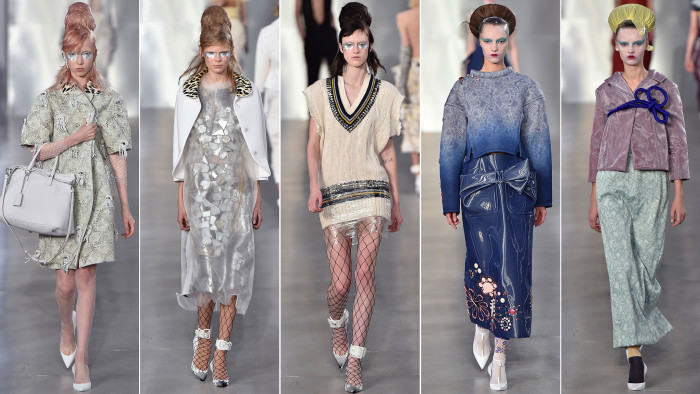Maison Margiela SS16 show report Paris Fashion Week

Simply sign up to the Life & Arts myFT Digest -- delivered directly to your inbox.
In fashion, as with so many things, “placement” is all. Where a show falls in the schedule can be almost as essential to its success or significance as the clothes showcased within it. And Paris, the most important of the fashion weeks, is one of the toughest arenas in which to get the right billing.
This season, however, a number of minor tweaks have seen the week recalibrated — and much for the better. Chloé has been one of the obvious beneficiaries: the house, often eclipsed by Céline, which has traditionally shown an hour before it, has escaped from the shadow of a Sunday afternoon billing to shine anew on Thursday — a day with comparatively little competition. And the absence of Givenchy, which showed in New York this season, will also allow a little more wiggle room for those cruising through the weekend catwalks.
Others are less advantaged. At Dries Van Noten, whose show has traditionally been recognised by the international press as marking the unofficial start of Paris Fashion Week, a funny little interloper upstaged proceedings today: Maison Margiela’s Tuileries show was held several hours before it. The label, now helmed by John Galliano, is sufficiently exciting that all the major foreign buyers, editors and writers were sat front-row. Well, we all knew Galliano doesn’t want for attention.
The designer’s fourth show as creative director of the house, which is owned by OTB entrepreneur Renzo Rosso, Margiela SS16 continued to build on the label’s current love for reinterpretation and reconstruction with a collection that was remade in simple furnishing fabrics, jumble and — occasionally — cling film. The show’s notes, written in Galliano’s typically romantic but opaque style, described it thus: “Garments touched by the patina of time, as archetypes are refracted through a whitewashed mirror. Antique technology is reverse-engineered beneath a soft filter to collide with rogue handicraft. Lo-fi, sci-fi, with a hi-fi finish.”
The looks were ladylike with a hint of otherworldliness — astronaut’s wife meets Martian. Jackets were curve-shouldered and 1950s in style, while neat pencil skirts were over-layered with films of texture. The flowwas then “interrupted” by more sculptural details: dresses tied at the bust with soft cord details; a mini bag suspended between the shoulder blades; a dress embellished with smashed-mirror appliqué; a jacket in palest glacier green hung with metallic threads; another stuck with pretty safety-pin blooms.
Dresses revealed both “heirloom ornaments” hidden in their folds and great daubs of colour, as though the models had sat on wet paints or leant against newly whitewashed walls while waiting backstage. While the looks were demure, there was subversion here: the models wore distressed bird’s-nest beehives dyed the colour of pale pistachio, and had silver Bowie eyes. Many of the most feminine looks were worn by hairy-legged men.
Curiously, it recalled the Prada show, another study in feminine dress codes and the rigour of a ladylike silhouettes: there were similar riffs on the skirt-suit here, and devilish little touches. The petals on a floral skirt had been snipped to create a spiky layer of intrigue, just as Prada’s brown skirt panels hinted at a glimpse of something other; the same metallic make-up, filmy layers and mirrored embellishment reminded me of Prada’s glittery paillettes. With running water now a fact on Mars, maybe these designers have got an eye on our intergalactic futures? Memo to Major Tom: bring fishnets and a stiletto heel.
This was a softer show of femininity, though, with lots of quilting and silky layers. An ochre, bias-cut two-piece glided over the body and swept the floor. It looked perfectly lovely — and then you saw the paint stains on the rear. The look, like the show’s new time slot, was a nice disruption.
For more reports from the shows, go to our fashion weeks page on FT.com
Photographs: Catwalking.com
Comments